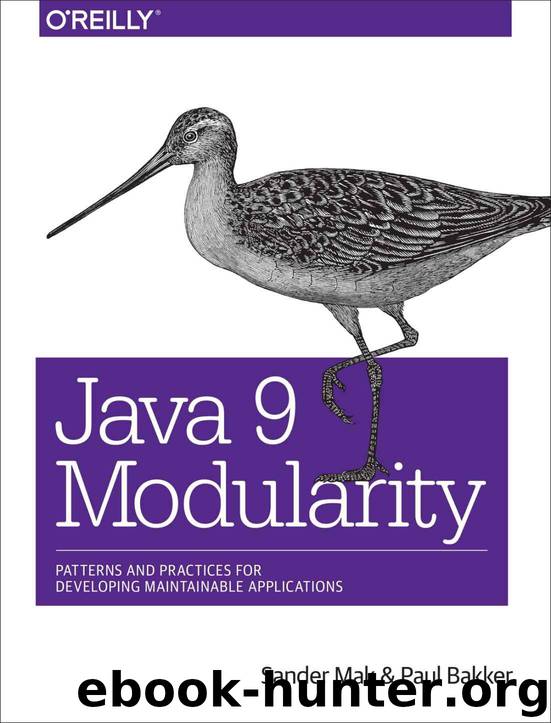Java 9 Modularity: Patterns and Practices for Developing Maintainable Applications by Mak Sander & Bakker Paul

Author:Mak, Sander & Bakker, Paul [Mak, Sander]
Language: eng
Format: azw3
Publisher: O'Reilly Media
Published: 2017-09-07T04:00:00+00:00
During layer creation, it’s possible to manipulate the modules that are loaded into the layer and their relations. That’s exactly what a container needs to do to get access to classes in the deployed application. Somehow the container needs to ensure that the package containing the class implementing ContainerApplication is open for deep reflection.
Cleaning up modules is done at the layer level and is surprisingly straightforward. Layers can be garbage collected just like any other Java object. If the container makes sure there are no strong references anymore to the layer, or any of its modules and classes, the layer and everything associated eventually get garbage collected.
It’s time to look at some code. The container provided as an example in this chapter is a simple command-line launcher that lists applications you can deploy and undeploy. Its main class is shown in Example 6-5. If you deploy an application, it keeps running until it is undeployed (or the container is stopped). We pass information about where the deployable apps live as command-line arguments in the format out-appa/app.a/app.a.AppA: first the directory that contains the application modules, then the root module name, and last the name of the class that implements ContainerApplication, all separated by slashes.
Usually, application containers have a deployment descriptor format that would convey such information as part of the application package. There are other ways to achieve similar results, for example, by putting annotations on modules (as shown in “Annotations”) to specify some metadata. For simplicity, we derive AppDescriptor instances containing this information from the command-line arguments.
Download
This site does not store any files on its server. We only index and link to content provided by other sites. Please contact the content providers to delete copyright contents if any and email us, we'll remove relevant links or contents immediately.
The Mikado Method by Ola Ellnestam Daniel Brolund(20604)
Hello! Python by Anthony Briggs(19900)
Secrets of the JavaScript Ninja by John Resig Bear Bibeault(18208)
The Well-Grounded Java Developer by Benjamin J. Evans Martijn Verburg(17576)
OCA Java SE 8 Programmer I Certification Guide by Mala Gupta(17422)
Kotlin in Action by Dmitry Jemerov(17185)
Algorithms of the Intelligent Web by Haralambos Marmanis;Dmitry Babenko(16236)
Grails in Action by Glen Smith Peter Ledbrook(15390)
Sass and Compass in Action by Wynn Netherland Nathan Weizenbaum Chris Eppstein Brandon Mathis(13266)
Test-Driven iOS Development with Swift 4 by Dominik Hauser(10393)
Windows APT Warfare by Sheng-Hao Ma(7833)
Layered Design for Ruby on Rails Applications by Vladimir Dementyev(7549)
Blueprints Visual Scripting for Unreal Engine 5 - Third Edition by Marcos Romero & Brenden Sewell(7448)
Solidity Programming Essentials by Ritesh Modi(4567)
Functional Programming in JavaScript by Mantyla Dan(4438)
Hands-On Full-Stack Web Development with GraphQL and React by Sebastian Grebe(4430)
WordPress Plugin Development Cookbook by Yannick Lefebvre(4384)
Unity 3D Game Development by Anthony Davis & Travis Baptiste & Russell Craig & Ryan Stunkel(4270)
The Ultimate iOS Interview Playbook by Avi Tsadok(4252)
